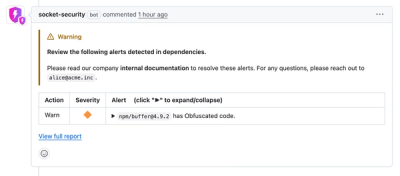
Security News
Crates.io Users Targeted by Phishing Emails
The Rust Security Response WG is warning of phishing emails from rustfoundation.dev targeting crates.io users.
Django-Dump-Die is a Django app that
provides a couple of debug tools, in the form of built-in methods
dump and dd. These allow sending details about a variable to the
browser for inspection.
Dumped variables are presented in an easy to read and fully expandable / collapsible tree. You can easily understand complex objects and the results of django queries with a simple call to either method.
When dump and/or dd are called, dump die will intercept the page
response and replace the contents of the response with detailed information
about the corresponding variables passed for inspection.
The entire concept is heavily based on the dump die functionality that comes with Php's Laravel and Symfony frameworks.
Full documentation on ReadTheDocs.

python -m pip install django-dump-die
settings.py file:
INSTALLED_APPS = [
'django_dump_die',
...
]
Add the corresponding middleware to your Django settings.py file:
MIDDLEWARE = [
'django_dump_die.middleware.DumpAndDieMiddleware',
...
]
Ensure that you have DEBUG set to True in your Django settings.py file:
DEBUG = True
:information_source: NOTE
Neither the dump command nor the dd command will do anything if DEBUG is not set to True.
With that said, this is a tool for debugging. You should not include this package
in production nor should you ever have DEBUG set to True in production.
From a file that is part of the request / response cycle such as a Django
View in views.py, make a call to dd sending it the contents of a variable
to inspect.
views.py
def my_awesome_view(request):
dd(request)
The middleware is where most of this package's heavy lifting happens.
By having the middleware installed, you can run dump(<variable>) and/or
dd(<variable>) in any file that is part of the request response cycle,
and it will run the dump logic. No importing or extra logic is required.
Each dump(<variable>) command will add the passed object to an internal
list that will be dumped either when a dd(<variable>) is used, or if the
entirety of the request finishes. You can have as many dump(<variable>)
statements as you want leading up to an optional dd(<variable>).
If you make a call to dd(<variable>), execution will immediately stop
and all dumped objects (including the the one sent to dd) will be output.
If you do not make a call to dd(<variable>) and only use
dump(<variable>) statements, the request will continue processing until
it is time to return the response. At this point, Django-Dump-Die will
intercept and replace the response with the data that has been dumped thus
far.
:information_source: NOTE
Because dump die uses middleware to internally handle keeping track of
what to dump and then actually dumping the data to the browser, any
call to dump or dd must be done in a file that will be processed
during the request response cycle. Most commonly this will be a
views.py file, but could also be utils called from a view.
Attempting to dump or dd from a console command will not work.
Example:
# Sample classes for output.
class EmptyClass:
"""Empty Class."""
pass
class SomeClass:
"""Some Class."""
SAMPLE_CONST = 41
def __init__(self, *args, **kwargs):
self.my_number = 32
self.my_string = 'A super cool string'
self.works = True
self.nothing = None
self.bytes = bytes('My Bytes', 'utf-8')
self.list_o_stuff = ['A', 'B', 'C']
self.sample_set = {'A', 'B', 'C'}
self.sample_tuple = ('A', 12, True)
self.empty_class = EmptyClass()
self.empty_class_dup = self.empty_class
def do_work(self):
"""Do some work"""
return True
# Example Usage
empty_class = EmptyClass()
some_class = SomeClass()
dump('Simple String')
dump(empty_class)
dd(some_class)

:information_source: NOTE Most editors will give a red error squiggle for the dd command. This is intentional, and the command will still run. This is because this command is meant to be used for debugging, and is not meant to stay long-term. The red squiggle helps identify it as something that should be removed before any actual commits.
For further documentation on usage and parameters, see ReadTheDocs/Usage
The package has a few available configuration options and settings, which are documented at ReadTheDocs/Configuration
FAQs
A Django app to add Laravel/Symfony-like dump and die functionality.
We found that django-dump-die demonstrated a healthy version release cadence and project activity because the last version was released less than a year ago. It has 1 open source maintainer collaborating on the project.
Did you know?

Socket for GitHub automatically highlights issues in each pull request and monitors the health of all your open source dependencies. Discover the contents of your packages and block harmful activity before you install or update your dependencies.

Security News
The Rust Security Response WG is warning of phishing emails from rustfoundation.dev targeting crates.io users.

Product
Socket now lets you customize pull request alert headers, helping security teams share clear guidance right in PRs to speed reviews and reduce back-and-forth.

Product
Socket's Rust support is moving to Beta: all users can scan Cargo projects and generate SBOMs, including Cargo.toml-only crates, with Rust-aware supply chain checks.